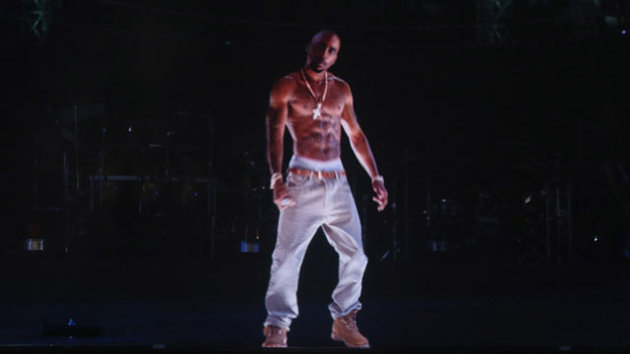
© ABC News
Remember when
Tupac made an appearance at last year's Coachella festival? It wasn't really Tupac but a holograph of the late rapper.
The holograph wasn't like watching a regular 3D TV image. You didn't need glasses, it was viewable to the entire audience, no matter what angle they were watching at, and it wasn't just a projected two dimensional image. It looked like Tupac was really on stage.
The engineers of the Object-Based Media Group at the MIT Media Lab, led by V. Michael Bove Jr. and his graduate student Dan Smalley, are working on technology that might enable that experience in your living room. The group is aiming to make true holographic videos not only a reality, but an affordable reality.
Sure, there have been other types of
glasses-free 3D screens and devices, including the Nintendo 3DS handheld gaming system or various 3D TVs shown by
Vizio and
Toshiba, but those have suffered from poor viewing angles, causing the image to be distorted when you move off the right or left. They also aren't considered true holograms.
What is a Hologram? What sets a
real hologram apart from the 3D technology seen in stores today is the way the pictures are constructed. Electronics like the 3DS and 3DTV TVs take two separate images and display them simultaneously through specialized materials that send one image to your left eye and the other to your right.
To your brain, this image mixture appears as if it has depth. The problem is that your head has to be in the right place. Viewing the display from a slight angle causes the depth to disappear, leaving behind two out of focus images layered on top of each other. Holograms, on the other hand, don't rely on this kind of optical illusion to project depth. It instead relies only on the physics of light.
You can think of it like a three-dimensional photograph that uses lasers instead of everyday light. One laser is shined on the holographed object while another laser bypasses the object completely. The two meet on a piece of holographic film and interfere with one another.
That interference pattern is what gets etched onto a piece of holographic film. To the naked eye, the film looks less like a photograph and more like a fingerprint. But when you shine a laser back onto the holographic film, it translates the interference pattern back into a 3D image.
It's the interference pattern that gives the projected object depth, as if it were really in the room. "Instead of just two views of the same object, you can have something like two hundred views," Nasser Peyghambarian, a professor of optical sciences at the University of Arizona, explained to ABC News. "When you look around the display, the depth will look continuous."
Faster, Yet Affordable ChipsThere are a few components that a TV would need to project a hologram, but new work on a chip out of Bove's lab paves the way. "Any electronic holographic display needs a chip that can make a whole lot of tiny pixels," says Bove. This new chip can generate billions of pixels that result in a bigger and more colorful hologram.
One of the breakthroughs of the lab's work, which will be published in this week's issue of the journal
Nature, is that the chip is able to transmit information about ten times more quickly than other holographic displays. "We've got 50 gigapixels per second," says Bove. "If you're watching an HDTV at 1080p resolution, that's about 100 megapixels per second. It's like 500 HDTVs all on one little chip."
A higher-resolution display is easy on the eyes but it often isn't easy on the wallet. Even some labs have trouble affording the equipment to do better holography research. But Bove adds that not only is the chip faster at transmitting information, but also costs much less.
"It only costs tens of dollars for the chip itself," he says. Even with all the specialized equipment, it only costs a few hundred dollars. He adds that everything the display uses "were all parts off of the shelf."
Compared to the $20,000 LCD or MEMS display which are normally used for holographic video, the new chip is a bargain. Peyghambarian sees Bove's cost-cutting research as a big step forward for holography. "A lot more people can get their hands on it," he says.
As for when we'll see Bove's work incorporated into new TVs, it may still be several years until the concept is perfected. The lab is also looking into how exactly to incorporate their chips into computer monitors and larger projectors.
However, Peyghambarian is optimistic and says that in time, "We should get large enough displays that will look like what we see outside our windows."
Source: ABC News
Reader Comments
to our Newsletter